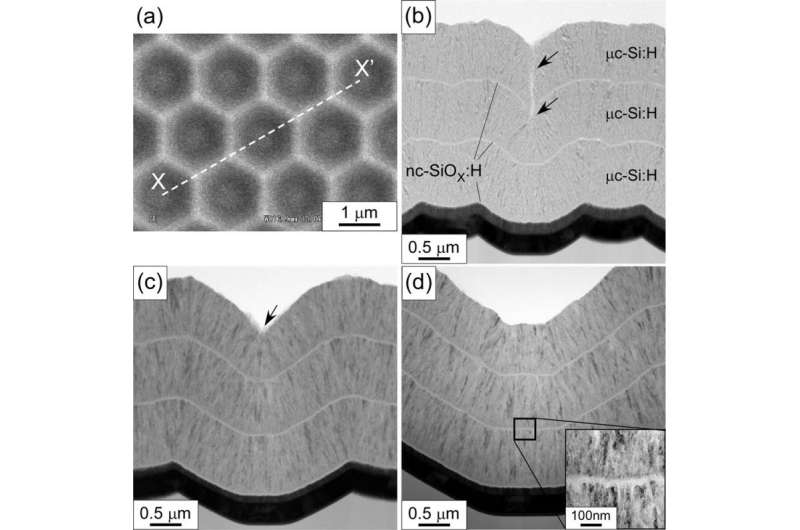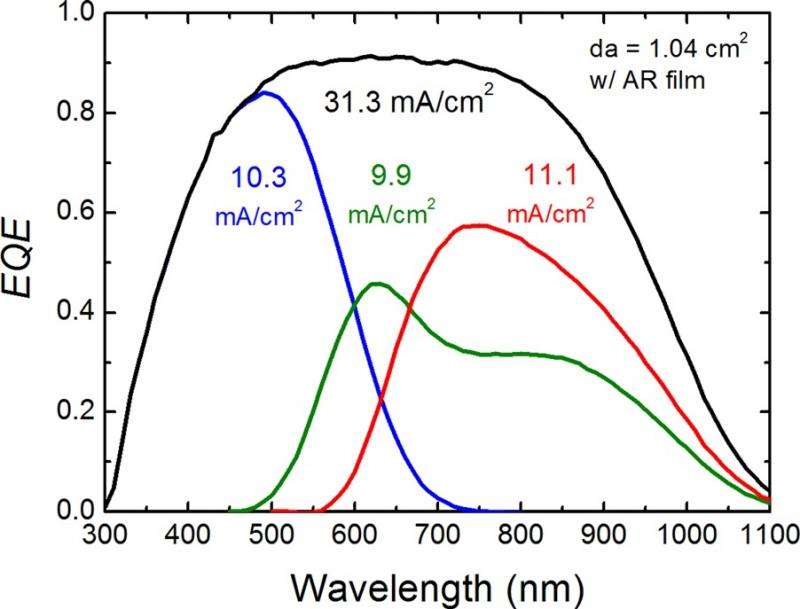June 4, 2015 feature
Solar cell sets world record with a stabilized efficiency of 13.6%

(Phys.org)—In a new study, scientists have reported a world record stabilized efficiency of 13.6% for a triple-junction thin-film silicon solar cell, which is a newer version of the single-junction thin-film silicon solar cell that has been used in commercial products since the 1970s. This value edges out the previous record of 13.44%, and the researchers expect that a few reasonable improvements will push it above 14%.
The research team, Hitoshi Sai, et al., consists of a collaboration from several of Japan's largest research centers: the National Institute of Advanced Industrial Science and Technology (AIST), the Photovoltaic Power Generation Technology Research Association (PVTEC), Sharp, Panasonic, and Mitsubishi.
"We think this paper presents two important results," Sai, a researcher at AIST, told Phys.org. "The first is the world's highest efficiency in thin-film silicon solar cells based on an advanced light-trapping feature. And second, the advanced light-trapping feature enables us to achieve a high potential photocurrent density (34.1 mA/cm2) with only a 4-um-thick microcrystalline absorber layer. With these results, we successfully demonstrated how light-trapping technology can contribute to boosting the photocurrent and efficiency of solar cells."
Because there are many different types of efficiencies when it comes to solar cells, it is often difficult for non-specialists to do direct comparisons. As the researchers explain in their paper published in Applied Physics Letters, stabilized efficiency is power conversion efficiency (PCE) that accounts for light-induced degradation. The difference can be significant, with stabilized efficiencies of around 13% having PCEs as high as 16%—a difference of about 20%.

"Sometimes solar cell efficiency causes confusion, as there are several definitions," Sai explained. "In general, any kind of solar cell shows varying degrees of degradation against prolonged exposure to light, humidity, temperature, and so on. Nevertheless, most solar cells are evaluated by their 'initial' efficiency. If the solar cell is relatively stable, such as crystalline silicon solar cells are, it's okay. However, it is well-known that amorphous silicon shows a significant degradation against prolonged light exposure, called the Steabler-Wronski effect, as described in our paper. To make a fair comparison, in this field, we compare solar cell performance after a common light-soaking procedure."
Numerous factors likely contribute to light-induced degradation in silicon solar cells, although the exact mechanisms are not fully understood. One design method for reducing light-induced degradation involves fabricating the solar cells on honeycomb-textured substrates. So far, the honeycomb textures have mostly been used for single-junction solar cells, which are made of just one semiconductor material and so can absorb light of only one wavelength.
In the new paper, the scientists verified recent research showing that the honeycomb texture can also be used to grow multijunction solar cells. Because multijunction solar cells consist of more than one semiconductor material, they can absorb multiple wavelengths of light. As with single-junction solar cells, the triple-junction solar cells fabricated here exhibit a superior light-trapping effect due to the honeycomb texture.
To further improve the efficiency, the researchers also carefully controlled the period of the honeycomb texture, incorporated an antireflection film based on a moth-eye structure, and positioned the three layers so as to maximize efficiency, among other strategies.
When testing the solar cell in their own lab, the researchers obtained initial and stabilized efficiencies of approximately 14.5% and 13.8%, respectively, indicating a light-induced efficiency degradation of less than 5%. The solar cell was also independently characterized by the AIST, which obtained a slightly lower official stabilized efficiency of 13.6%. The researchers explain that the discrepancy likely arises from differences in the solar simulators used in testing: the scientists' own lab used a dual-light solar simulator, which is richer in blue wavelengths than the more accurate triple-light solar simulator used in the AIST lab. The solar cell was optimized for spectrum generated by the dual-light solar simulator.
Despite setting a new record, the researchers believe there is still much room for improvement, in particular by improving the performance of the top layer of the triple-layer solar cell and by addressing the spectral mismatch. By improving in these areas, they predict that this approach will achieve a stabilized efficiency above 14% in the near future. In addition, the researchers would like to apply this new knowledge on light trapping to conventional wafer-based silicon solar cells.
More information: Hitoshi Sai, et al. "Triple-junction thin-film silicon solar cell fabricated on periodically textured substrate with a stabilized efficiency of 13.6%." Applied Physics Letters. DOI: 10.1063/1.4921794
Journal information: Applied Physics Letters
© 2015 Phys.org





















